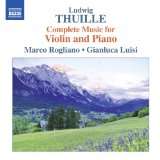|
Back
02/20/2013
Ludwig Thuille: Violin Sonatas n° 2 in E minor, opus 30, & n° 1 in D minor, opus 1 – Allegro giusto, opus 39
Marco Rogliano (Violin), Gianluca Luisi (Piano)
Recording: Teatro La Nuova Fenice, Osimo, Italy (July 19-21, 2011) – 58’ 05
Naxos #8.572870 – Booklet in English

   
The name Ludwig Thuille runs by classical music just like a grace note runs through a staff in a flittering moment. Though barely mentioned in a sentence, Thuille’s contributions were significant. Ludwig Thuille is best remembered through his teachings, being instructed at the Royal Music School under mentors Josef Rheinberger and Karl Bärmann.
The Violin Sonata n° 2’s “Allegro appassionato ma non troppo mosso” has the fieriness of Franz Liszt in which Marco Rogliano plays with tentative fervor. The articulation appears shallow, especially in ending notes that tend to fall off and becoming obscure. Rogliano, however, concludes the “Finale: Allegro deciso” with resolve by demonstrating some passionate, nimble fretwork.
Dedicated to teacher Josef Rheinberger, the opening movement, “Allegro risoluto” of the Violin Sonata n° 1 in D minor, serves more harmonic delight than its predecessor in which Luisi’s piano dialogues back and forth between Rogliano and pulsates with spots of Chopinesque chording. This selection is momentous and visionary. The structural repeats in sonata-allegro form demonstrate the qualities characteristic of Thuille’s teachings.
In the ensuing scherzo we hear an abbreviation of Schubert’s third movement “Scherzo-Presto” from the Trout Quintet. Luisi’s ascendant piano arpeggios patter happily against Rogliano’s descendent arpeggios with great ornamentation on the front and back sides. Thuille’s pacific “Adagio cantabile” paves way for Rogliano’s melodic lines with reserved plausibility.
Within the Allegro giusto both parties divvy up moments of artistic spotlight and, combined, create a sufficient journey of musical delight.
Christie Grimstad
|